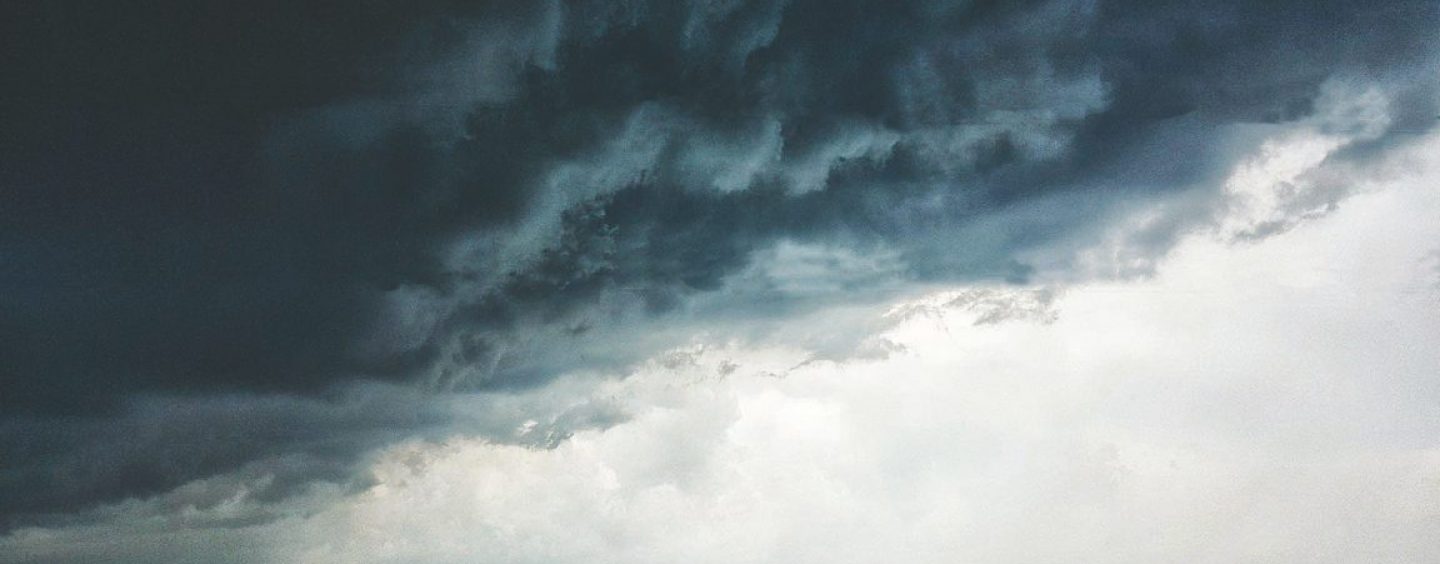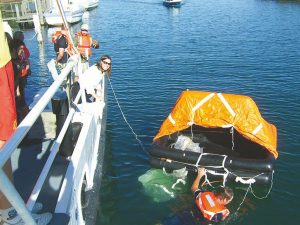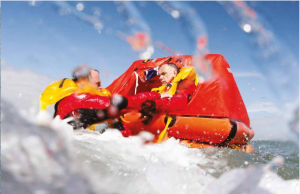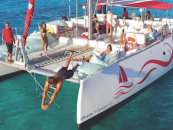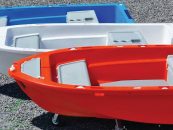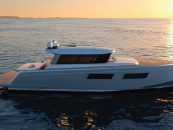YOUR LAST CHANCE AT SURVIVAL
By Jackie Parry for Pantaenius Sail & Motor Yacht Insurance
Chatting with friends and colleagues in the boating industry, it was agreed that a liferaft should be renamed. The term implies it will save our life. And it may. But making the decision to deploy the ‘liferaft’ prematurely could mean disaster – a disaster with no return.
STORMS ARE BRUTAL! – Storms toss boats around as if they are made of foam. The noise is horrendous. Vortexing winds clutch you in its vicious fist, backing, clocking in a gut-wrenching horrifying lurch from one direction to another. The cruel gusts pin you down, then pick you up and hurl you forward. The great barrelling wall of wind smacks the boat. The walls of water crash into the hull, leaving you wondering why it doesn’t smash into a thousand pieces. Nature puts on a performance of ear-splitting music – the beating halyards and howling winds clashing together, reaching a cliff-hanger crescendo. It’s black, the rigging screeches a death howl. Things break. The boat is out of control. There is water inside. There is mess. You are sick. You are completely and utterly terrified.
You just want to get away from this mayhem. But if you are not sinking, you must fight this urge. LASTRAFT – A liferaft should be called ‘lastraft’ – as it is the very last thing you can try to save your life. It’s the last-ditch attempt to survive. And it ‘may’ keep you alive – just. It should be called a lastraft as there is only a few inches of air and thin fabric keeping you alive.
TRAINING – A sea survival course is imperative for anyone going out on the water. But it’s easy to forget that the training cannot reproduce reality. Sitting in the lastraft is a bit of a giggle. Flat water, huddling with strangers, having fun in a swimming pool or protected harbour. The little dome of orange is comforting; warmth from other bodies and camaraderie gives a false sense of what it would be like.
REALITY – If you are in a lastraft, chances are it is due to bad weather. Huge waves will pummel the soft raft, flip you, and make you sick. You will be sitting in urine and vomit and you will be tumbling around mixing with the fluids and with other, heavy bodies… elbows, feet, faces. A diabolical concoction of human waste and limbs. If two of you are in a six-man lastraft, then prepare for the ride of your life. There will not be enough weight to maintain stability.
If there are two of you in a two-man lastraft, prepare for smelly and uncomfortable intimacy.
IMAGINE – Imagine how you will go to the toilet if the waves are eight metres high for four days. You can add constipation to the list of realities. Think about sitting in salt water for days on end (with all the other fluids as mentioned), and what that will do to your skin as you slip-slide. And before all these quiet contemplations, imagine how on earth you are going to physically get into your lastraft, in total darkness, in big seas with the wind desperately trying to snatch it away from you.
RIDING OUT A STORM IN LASTRAFT – I’ve been through storms, but not in a lastraft. I have sat in lastrafts, but in calm water. I have trained commercial skippers in sea survival. Here, I am simply putting together the horrifying mix that we all want to avoid. But we must think about the possibility, as this could happen to any of us whenever cast off.
WHEN TO USE A LASTRAFT – You deploy a lastraft when there is literally nothing else, not a thing – when you have to step up into it, when it is the only thing left to save you.
EASIER SAID – No, it’s not easy. It’s terrifying. And the decisions made when in the thick of this nightmare must not be judged. We can only discuss, enlighten, and support. A soft little orange boat sounds like a good idea. You can snuggle inside, close off the storm. After all, it is a ‘liferaft’ and you feel like you are going to die. More often than not, your boat can handle it. More often than not, your boat will keep floating. Clearly this depends on the problem. And, yes, boats do sink, and if this happens you MUST, of course, use your lastraft.
BUT, if your boat does not sink, IT IS YOUR VERY BEST OPTION FOR SURVIVAL.
Tony Bullimore’s story proves this point.
https://www.bbc.co.uk/programmes/articles/QP4X2nDwhwhZLRwrSg1sK5/i-was-theretony-bullimores-ocean-rescue-1997
The boating community is one of the most supportive groups I have the pleasure to belong to. So, let us not judge when we have not had to face this appalling decision. But please share this article. If it helps just one person pause for thought and reconsider abandoning their ship too early, then it is worth a moment of our time to share. Please add your thoughts too. I wish you safe sailing.
STORM PREPARATION TIPS:
- Ensure those who are off watch get good rest (alter the watch schedule so everyone has some rest prior to the storm).
- Prepare plenty of easy-to-reheat/grab food. Eat something before the storm hits.
- Rig storm main early. A separate track for your storm main is important, so it’s ready to go. Make ready the jib (i.e. so it’s not buried in the sail locker).
- Batten down the hatches: Check everything – the sole (floor) of the boat, all hatches are dogged (including under bunks), items can’t shift in cupboards, books are held down.
- Report your position, if possible (radio schedule, shore based station, another vessel).
- Study charts for alternatives – double check possible dangers (shallows, currents, reefs, etc).
Turn back! What is the best route? If it is back from where you came, that can sometimes be a better alternative. A safe voyage is a successful voyage; the start/finish points are irrelevant.
- Bolt in the storm boards early (if fitted) to all large ports, windows, etc.
- Wet weather gear should be out and ready.
- Bilges are clean and clear.
- Check that your bilge pumps are working properly.
- Press fuel tanks up if you can (i.e. fill them right up). Empty the jerries into your tank if you carry them. (Full tanks prevent free surface effect and help to stabilise the vessel).
- Lower all weight where possible. To maximise the stability of your vessel, all heavy items must be stowed (and lashed carefully) down low in the vessel and in the middle. This is why we say dinghies should never be carried on the transom at sea.
- The outboard: if it is carried on a rail, can you secure it below decks?
- Bow anchor is secured or stowed.
- Grab bag ready to grab. (It should always be ready to go).
- Keep your fluids up. Take seasick remedy early even if you don’t usually suffer.
- Weather: Remember that they are called weather ‘forecasts’ and they offer no guarantees.
You will need to study the big picture via synoptic charts. Obtain weather forecasts and track the storm’s position and movement. Try not to rely on one source of information. Work out the best track to sail (the safe/dangerous semicircle – see below).
- Keep an eye on the barometer. Remember that it will start to rise when the storm has passed over, but the sea-state will take longer to settle.
- Wear a life jacket and issue one to all on board, making sure they put them on.
- Have torches and head lamps ready.
- Have snorkel gear (dive goggles) ready for going outside, if necessary.
- Have wet weather gear and harnesses easily accessible.
- Above decks: Remove/lash down anything loose. Stowing below is best.
- Turn off the wind generator, lash down the blades or remove them.
- Check the self-steering gear, vane, and paddle.
- Secure all vents.
- Ensure propane tanks are secure using additional lashing.
- Remove winch handles from the mast.
- Stow jerry cans below where possible.
- If you have an inflatable dinghy on deck, deflate and store below.
- Remove biminis/dodgers and any canvas, where possible.
- Test radios, if possible.
- Have extra bungs and a hammer at the ready, especially adjacent to seacocks.
- Lock all lockers and drawers and the oven door.
- Go through the entire boat, checking everything is secure.
- Rig up your lee cloths with additional lines to help keep you in the bunk.
- Lash your full water jerry cans together in readiness, in case you abandon ship. (They will float, saltwater is denser than fresh.)
- Review lastraft procedures and check all emergency equipment, flares, etc.
- Clear the navigation station of all plotting instruments.
If you are cruising in a cyclone area during cyclone season, ensure you understand the usual behaviour of the storm within your location. Analyse the best track to sail should you be caught in a cyclone.




















